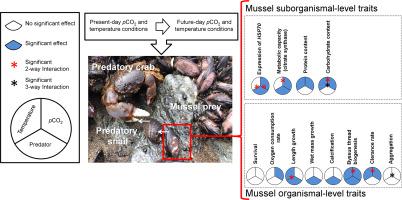Science of the Total Environment ( IF 9.8 ) Pub Date : 2021-02-19 , DOI: 10.1016/j.scitotenv.2021.145916 Patricio H. Manríquez , María Elisa Jara , Claudio P. González , Mylene E. Seguel , Paolo Domenici , Sue-Ann Watson , Cristóbal Anguita , Cristian Duarte , Katherina Brokordt

|
In order to make adequate projections on the consequences of climate change stressors on marine organisms, it is important to know how impacts of these stressors are affected by the presence of other species. Here we assessed the direct effects of ocean warming (OW) and acidification (OA) along with non-consumptive effects (NCEs) of a predatory crab and/or a predatory snail on the habitat-forming mussel Perumytilus purpuratus. Mussels were exposed for 10–14 weeks to contrasting pCO2 (500 and 1400 μatm) and temperature (15 and 20 °C) levels, in the presence/absence of cues from one or two predator species. We compared mussel traits at sub-organismal (nutritional status, metabolic capacity-ATP production-, cell stress condition via HSP70 expression) and organismal (survival, oxygen consumption, growth, byssus biogenesis, clearance rates, aggregation) levels. OA increased the mussels' oxygen consumption; and OA combined with OW increased ATP demand and the use of carbohydrate reserves. Mussels at present-day pCO2 levels had the highest protein content. Under OW the predatory snail cues induced the highest cell stress condition on the mussels. Temperature, predator cues and the interaction between them affected mussel growth. Mussels grew larger at the control temperature (15 °C) when crab and snail cues were present. Mussel wet mass and calcification were affected by predator cues; with highest values recorded in crab cue presence (isolated or combined with snail cues). In the absence of predator cues in the trails, byssus biogenesis was affected by OA, OW and the OA × OW and OA × predator cues interactions. At present-day pCO2 levels, more byssus was recorded with snail than with crab cues. Clearance rates were affected by temperature, pCO2 and the interaction between them. The investigated stressors had no effects on mussel aggregation. We conclude that OA, OW and the NCEs may lead to neutral, positive or negative consequences for mussels.
中文翻译:

气候变化压力源和掠夺性线索对贻贝物种的综合影响
为了对气候变化压力源对海洋生物的后果做出充分的预测,了解其他物种的存在如何影响这些压力源的影响非常重要。在这里,我们评估了海洋变暖(OW)和酸化(OA)的直接影响以及掠食性螃蟹和/或掠食性蜗牛对形成栖息地的贻贝红霉菌紫癜的非消耗性影响(NCE)。贻贝暴露10–14周,对比p CO 2(500和1400μatm)和温度(15和20°C)的水平,是否存在来自一种或两种捕食物种的线索。我们比较了亚生物(营养状态,代谢能力-ATP产生-,通过HSP70表达的细胞应激条件)和机体(生存,耗氧量,生长,结缔生物生成,清除率,聚集)水平下的贻贝性状。OA增加了贻贝的耗氧量;OA与OW相结合,增加了ATP需求并增加了碳水化合物的使用量。贻贝目前的p CO 2蛋白质含量最高。在OW下,掠食性蜗牛线索在贻贝上诱导了最高的细胞应激条件。温度,捕食者线索以及它们之间的相互作用影响贻贝的生长。当存在螃蟹和蜗牛线索时,贻贝在控制温度(15°C)下变大。捕食者线索影响贻贝的湿质量和钙化;在螃蟹提示存在下(隔离或与蜗牛提示结合)记录的最高值。在线索中没有捕食者线索的情况下,by的生物发生受到OA,OW以及OA×OW和OA×捕食者线索相互作用的影响。在当今的p CO 2水平下,蜗牛记录的by病比螃蟹提示的多。清除率受温度p CO 2的影响以及它们之间的相互作用。研究的应激源对贻贝聚集没有影响。我们得出结论,OA,OW和NCE可能导致贻贝的中性,积极或消极后果。


























 京公网安备 11010802027423号
京公网安备 11010802027423号